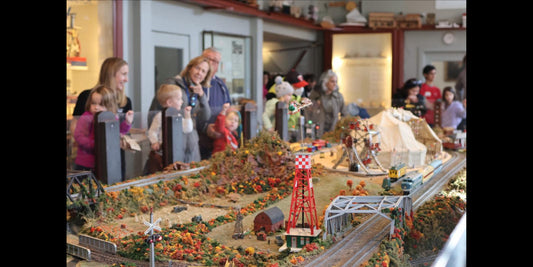New Haven has been many cities in its nearly 400 years. Picture this one: streets nearly devoid of cars due to severe gas rationing; Yale men running each morning at six o’clock, shouting “hut two, hut two” and sometimes stopping trolley traffic; a daily military parade to the Green with marching music by Glenn Miller’s 418th Army Air Force Band. This was New Haven during World War II, a city subject to nighttime blackouts, air raid drills and a major influx of military personnel and factory workers.
When Pearl Harbor was bombed by Japanese forces on December 7, 1941, students at Yale were visibly shaken by the news, according to an account in The Story of Undergraduate Yale in the Second World War (1960) by Loomis Havemeyer. Their anxiety quickly turned to bravado. “That night more than a thousand students collected on the old campus with a spirit usually confined to a football rally,” Havemeyer writes. “The demonstration ranged around town far into the night.”
In the coming year, residents were issued “basic A books containing 48 coupons good for four gallons” of gasoline, according to a news account at the time. Also rationed were tires, heavy rubber goods, coffee and sugar, with an allowance for consumers who needed it for canning fruit, preserves, jams and jellies. More than 1,000 public school teachers took on the Herculean task of registering all 162,000 New Haven residents for ration books.
Physical spaces in the Elm City changed as well. A USO lounge was opened on the south balcony of the New Haven Railroad station, “the first of its type in the state, with sleeping accommodations and staffed for 24-hour operation,” one newspaper reported. The tony lobby of the Hotel Taft became a collection area for scrap metal, according to Elms, Arms & Ivy: New Haven in the Twentieth Century (2000) by Robert J. Leeney. A “Victory House” was built on the Green as a central location for the purchase of war bonds. A 1944 New Haven Journal-Courier news item noted that the sale of “E Bonds” in New Haven had reached a total of $8,500,000 during the Fifth War Loan Drive, which would be an impressive number even today.
“There were trains full of draftees from the region leaving the New Haven rail depot weekly,” Leeney writes. “Each departure was shadowed by news of continuing calamity in the Pacific.” July of 1942 marked a mass exodus of Yale students and personnel. A Yale Unit of 48 physicians, 7 dentists, 103 nurses and civilian specialists was called up for active duty, and a Journal-Courier photograph shows the “first mass enlistment” of Yale students that same month, their faces betraying emotions ranging from excitement to concern. By then, Yale undergraduates had been put on a regimen of physical exercise “designed to make them rugged and physically alert,” Havemeyer writes, including swimming, boxing, wrestling and obstacle courses. Students also went to work in Greater New Haven, helping farmers pick apples due to a labor shortage, covering night shifts for the Coast Guard Auxiliary, keeping night watch in the canteen at the train station and assisting doctors and nurses at the New Haven Hospital. By July of 1943, only 928 civilian students remained on campus, down from a prewar enrollment of more than 5,000.
In the absence of so many students, Yale’s buildings were turned over for military use. In January of 1943, 3,000 Army Air Force cadets arrived, taking over much of Old Campus. In July they were joined by 1,500 Navy men and 300 Marines. Engineering was a popular course of study among the military students. Army Military Intelligence officers learned Mandarin Chinese, reportedly in order to teach troops in China how to use US weapons. Officers in the Civil Affairs Training Specialists program studied Japanese and the Far East. Others prepared for medical training.
Crammed four to a double room, tensions sometimes ran high. According to Havemeyer, the Army and Navy men had their own on-campus battles. “The air boys would yell, ‘When I was a teeny-tiny little boy my mamma dressed me up in a nice sailor suit, too.’ The result was a barrage of Coke bottles that shattered many windows.”
When the war in Europe came to an end in May of 1945, New Haveners reacted with restraint, knowing that “thousands of young Americans had to die or be maimed to make victory in Europe possible and that a difficult war with the ruthless Japanese remains to be terminated before full peace is restored to the world,” the Journal Register reported. But following the August surrender of Japan, the city let loose. “Wild Scenes Mark City’s Celebration,” read the headline in the Register. The festivities reportedly included fireworks, cars “decked with flags and trailing old tin cans,” “hornblowing, whistling, and impromptu parading,” girls embracing the Army and Navy men walking up Church Street and the firing of guns. “It is a rare sight for staid old New Haven,” the Register observed.
According to Leeney, “an estimated 25,000 New Haven area draftees had seen service all over the world” during the course of the war. Some of their recollections were recorded in a series of pamphlets published by the state in 1945 and ’46 titled Connecticut Men of the United States Army. Their stated aim was to “record without embellishment, the mood, the impressions, the exciting events, of the worst and best of the great days, before time blurs memories…” (A copy of the series is shelved in the Ives Main Library’s local history room.) Military records of the National Archives indicate that 1,146 New Haven County residents lost their lives in World War II.
The end of the war brought with it a new set of challenges for New Haven as veterans returned home looking for work. A veterans center was opened at the former Cedar Street School to aid their transition. Some at Yale hoped the university might return to a nostalgic past. “They envisioned the gracious living of other days with two men in every double suite, the reinstitution of College dinners, the closer relationship between Fellows and students, and other things that made life very well worth while,” Havemeyer writes. “But these things were not to be.”
Instead, the largest incoming class in the university’s history arrived, dorm rooms were over capacity, 336 students were housed on the basketball court until more housing could be built and “
Few physical reminders remain today of that wartime New Haven, but like its biggest university, the city had been indelibly changed. There was no going back.
Photo Key:
1. Drilling on the New Haven Green circa 1943, courtesy of Magrisso Forte.
2. Locally issued ration stamps in the New Haven Museum’s collection.
3. “Members of the Naval Reserve Officers Training Corps marching on the Old Campus,” as depicted in A Yale Album: The Third Century (2000).
4. Wartime parade along the New Haven Green on July 4, 1942, courtesy of Magrisso Forte.
Written by Kathy Leonard Czepiel. Image 2 photographed by Kathy Leonard Czepiel. Image 3 photographed by Dan Mims. This story was originally published on June 4, 2019.







